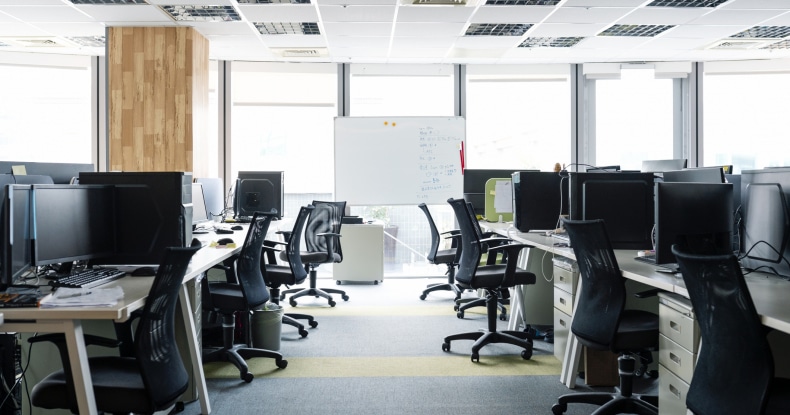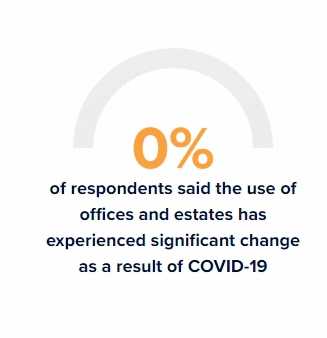The pandemic now has around 2.6 billion people living under some sort of lockdown or quarantine. The social and financial impact is undeniable as people stay home, offices and shops close, and our economy effectively stalls.
In real estate & property management terms, the pandemic will certainly have an impact as remote working becomes popular and organisations realise you don’t need an office building to be productive. The concentration of work and living space is now under scrutiny. How will that affect the public sector?
RingCentral UK recently conducted a public sector survey in which 46% of respondents said the use of office and estates has experienced significant change as a result of COVID-19.
It is hard to predict the return-to-office date for the UK, let alone the public sector, as it’s influenced by so many factors. The public sector is in a unique position where a certain amount of in-person interaction is needed to deliver citizen services (construction, community programmes, healthcare etc.). It is safe to assume that some form of remote work will stay with us going forward.

The emergence of “hot-desking” in the public sector
An immediate and easy-to-implement response could be the introduction of hot-desking. One of the biggest benefits of hot-desking to budget-constrained entities is cost reduction. Hot desking helps cut down expenses by eliminating the amount of office space an organisation needs, as on any given day 30-50% of the workforce is expected to work from home. It’s useful for departments where workers spend a lot of their time travelling, are in-field staff or can easily spend part of the week working remotely.
Another benefit is that hot-desking allows your employees to work near colleagues they would normally not see otherwise. This strengthens relationships, promotes better teamwork, and improves inter-departmental collaboration.
Of course, if hot-desking is to be adopted in a post-pandemic world, there would need to be a focus on desk-cleaning practices along with a period of “no bookings” for safety measures.
Many UK institutions have adopted these strategies even before the pandemic to slash big budget items like corporate real estate. Most notably, BT shut down more than 270 UK offices as part of a three to five-year grand plan to carve out £1.5B in expenses from its operating budget. Going forward we anticipate more of these consolidation efforts emerging in the public sector to account for pandemic losses in taxpayer revenues.
Read BT’s case study: Flexible working in BT – the conference powered agile enterprise
Evaluating the office through a post-pandemic lens
In the UK, the Office for Budget Responsibility (OBR) has set out a scenario in which public finances could be hit harder by the coronavirus than the 2008 global financial crisis. Reducing property footprints and budgets will be key to evolving past these struggles. According to a recent Gartner survey, 74% of CFOs plan to move at least 5% of their on-site workforce to remote positions permanently after COVID-19.
Read PWC survey response: The post-pandemic CFO cheat sheet
Public sector organisations will not go back to the way we knew before the pandemic, but will reinvent themselves to be more resilient, adapting their operational models to the new normal. While some voices are predicting the death of the office, we don’t think that will be the case. Social distancing has highlighted the value of day-to-day interactions as a key ingredient for innovation. The physical office will continue to play a role in facilitating collaboration, employee mental health, well-being and productivity. It is likely to cater for face-to-face and large group interactions. Fewer cubicles and more meeting rooms.
A catalyst for change: Public sector adopting flexible space models (think WeWork)
The flexible space sector, which in recent years has accounted for a substantial share of commercial real estate consumption, has fallen flat as a direct result of the COVID-19 outbreak. WeWork, which was the industry’s darling at one point, is now at serious risk of defaulting due to the effects of the pandemic.
In the long term, demand for flex space will continue to be important to the success of our economy. Though this has traditionally been used by high tech SMBs, public sector organisations and perhaps third sector (non-profits, housing associations and charities) may employ this strategy to maximise their budgets. Many organisations will be anxious not to commit to big CapEx projects or make any firm employee headcount forecasts, which will strengthen demand for shared work spaces.
For the public sector to realistically adopt this new model, there would need to be structural changes to how these spaces are used including lower employee density per square metre and deployment of robust network security infrastructure to protect sensitive information. This infrastructure is all available in today’s world and is easy to implement. The flexi space industry will need to adapt to highly regulated clientele coming into their spaces.
Public sector office re-entry checklist
While we don’t know when we will be able to return to the office, there is no harm in preparing your organisation’s return to the office plan. Here is our high level checklist of things to consider before opening the doors:
1. Work style adaptations
- Reduce workplace density – redesign spaces to maintain new distancing standards
- Create new protocols to reduce gatherings in the office
- Provide new onsite facilities to reduce the need to leave (e.g. cafeteria)
- Enable remote working to continue (through technology and tools)
- Limit sharing of equipment wherever possible
- Encourage people to adapt to new practices to limit touching shared equipment (e.g. encourage less printing)
2. Asset and people protection
- Provide full protection of your staff through hygiene solutions. Visible and well-trained cleaning staff will be critical
- Create staff commuting plans and protocols to stagger staff start times to reduce congestion in lifts
- Create employee and visitor screening protocols (taking temperature etc.)
- Consider asking (not mandating) your whole organisation to download a contact tracing app (for their own and colleagues’ safety)
3. Workforce communications
- Provide details on the above plan and instil confidence that it is safe to come back to work
- Create an eligibility plan for returning to the office and identify priorities of re-entry
- Critical activities and sites identified
- Create a training and education programme to prepare for return to work
- Provide mental health support
Looking beyond the pandemic
Our new normal will take time to evolve. New trends are already starting to take shape as governments, businesses and communities begin to adjust. Returning to work means reaching an optimal solution where the trust of people in their government is beyond expectations. The physical and digital transformation of our offices is instrumental in reaching this state and crucial to getting back to work. New habits and behaviours will need to be adopted and educated. This reset will lay the groundwork for reimagining the new workplace as a distributed model rather than a singular place.
Originally published Nov 16, 2020, updated Apr 15, 2021



